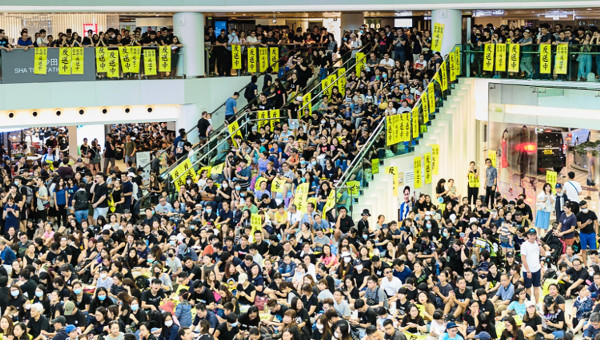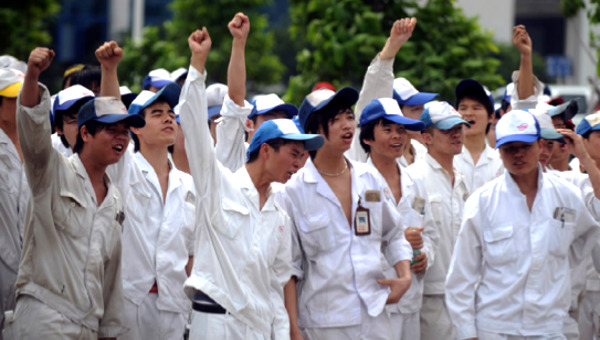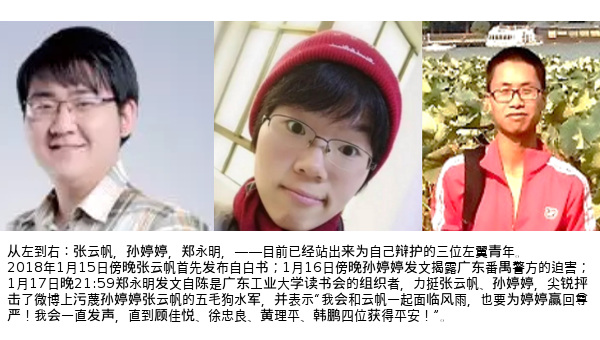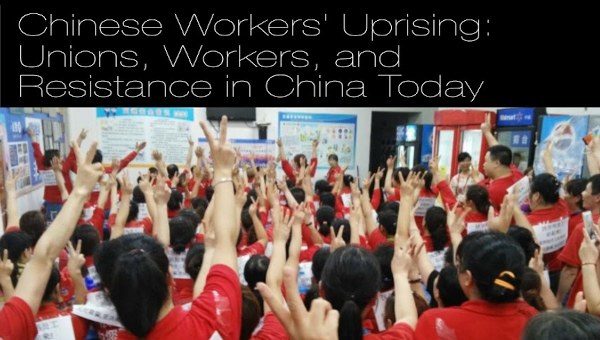It is impossible to ignore the large and growing wave of worker strikes and protests now rocking China. Just last year there were over 2700 actions, double the numbers of 2014 and more than 500 during this past January alone. They are in response to the Chinese government’s restructuring program of wage cuts, worker layoffs, and workplace closures during an economic slowdown and plans to move away from the export-oriented strategy followed in this stage of the reform period.
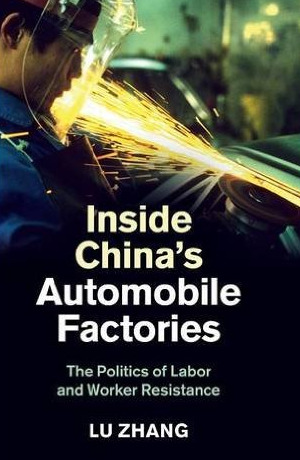
The protests often include appeals and references by participants to the traditionally stated values and promises of the Chinese Communist Party (CCP) about liberation and the interests of the working class, which are now being trampled by the actions of the capitalist regime.
In addition to arresting activists and closing key autonomous worker centres, the authorities are carefully attempting to balance their responses to worker militancy with a combination of concessions in a number of local demands for severance, pension payments and wages, and strategic efforts to limit the protests to local and economic issues.
Explaining the ongoing working class resistance, its forms, expressions, potentials and limits, along with the particular approach of the CCP and state
is a complex and challenging exercise.
The Promise of Resistance in China’s Auto Sector
In Inside China’s Automobile Factories: The Politics of Labor and Worker Resistance, (Cambridge University Press, 2015, 206 pp.) author Lu Zhang, provides a brilliant and profound set of explanations, rooted in an exhaustive study of China’s auto sector. She spent 20 months between 2004 and 2011 doing ethnographic research in seven large auto assembly plants (state-owned and joint ventures), in six cities. Zhang spent two months at each facility interviewing workers (as well as managers) on the shop floor, in work group meetings, during workers’ spare time, spending two months at each facility. Interviewees included permanent, temporary and student, workers, as well as party, union and managerial cadre; arbitrators; government officials; scholars and auto industry experts.
The study’s broad sweep includes the transformation of the industry from the beginning of the reform period in the late 1980s and early 1990s through today; the change in political and economic context that drove changes in the organization of production and the structure of the workforce; relations between labour and management and within the workforce; the effects of the developmental capitalist path chosen by the post-Mao leadership; and how the political and ideological framework inherited from the state-socialist era both shaped forms of labour control, but resistance as well.
Lu Zhang is an assistant professor of sociology at Temple University and was originally a Chinese national. Her research on labour movements and the history of working class struggles has been strongly influenced by the work of the late Giovanni Arrighi and Beverly Silver with whom she worked closely, reflecting many elements of their analytical perspective.
For Zhang, the auto sector is paradigmatic and central for explaining the larger structural changes in the Chinese economy, and in particular, the role and experience of the working class as a whole. As such, autoworkers form a basic driving force and model for labour unrest in China (and, in Zhang’s view, they play a similar role in other societies). Key components of the auto industry drive this dynamic. They include the central importance placed by the state in building a national auto industry through state-owned and joint ventures; the state’s potential for building deeper industrial and manufacturing capacity; its central role in capital accumulation and the forms of labour organization that it has pioneered.
A number of factors shape the particular role that autoworkers play – in their potential to engage in defensive struggles (in turn shaped by their strategic role in production) the vulnerabilities of the now prevalent lean production workplace regimes and their historical role as a beneficiaries and collective actors in China’s industrialization in the state socialist period. But the challenges facing the Chinese state in a capitalist market environment – both in China and the world economy it has chosen to enter – have structured forms of labour organization that limit and shape their capacity to defend themselves and act as protagonists.
The key to her approach is what she calls “a fundamental underlying contradiction between legitimacy and profitability that has characterized capitalist development (in China) and more specifically, efforts to resolve a crisis of profitability tend to create or exacerbate a crisis of social legitimacy” [11].
China is clearly seen as having a form of capitalist system, and the basic analysis is set in the context of the ongoing commodification of labour. She notes:
“This book is therefore also about the social-political contradictions of the development of capitalism – that is, the move toward commodification of labour and its countermovement – in post-socialist China” [14, my emphasis].
The political and ideological influences originating in the founding revolutionary and state socialist project retain strong roots in the working class and affect the relationships between the working class, the ruling party and state. The requirements of its drive toward development and capital accumulation place its auto industry (both state-owned and joint enterprises) in a context of intense competition. Profitability and accumulation in this era require constant cost reduction and adoption of forms of lean production, just-in-time practices and forms of labour segmentation/dualism.
The Institutional Power of Workers
What helps make this book so compelling and insightful is the analysis of the factors which drive the legitimacy aspect of the larger contradiction. It explains key sources of workers’ institutional power – even if mediated – in the context of the constant restructuring of the Chinese economic apparatus, and in particular the auto industry’s labour regime, as it attempts to combine capitalism with structural and ideological holdovers from the old regime.
The regime finds legitimacy amongst the working class through a number of sources. The end of the semi-feudal, weakened and dominated China through the revolution led by the CCP is celebrated by working people. The revolution was made in the name of the entire Chinese people, and promised to build a society that favoured the working class. The state socialist system did provide guaranteed work, benefits and a promise of a better life. That promise and the prestige of the system remain part of the ideological apparatus of the CCP and are reflected in the aspirations of working people in China.
There were numerous experiments in participatory and anti-bureaucratic working class engagement over the years during the Maoist period. She describes a number of experiments which combined worker participation in management (albeit limited), and management working alongside with workers, such as the Angang Constitution of 1960 [24]. The party had over the years developed a leadership style combining authoritarian power that worked with and listened to working people, called the Mass Line. It promised to respect the “legitimate rights and interests of workers” [14].
When the CCP adopted a strategy of capitalist development – which involved the ongoing commodification of labour, its claims to legitimacy within the working class changed.[1] The appeal is now based on the promise of growth and the maintenance of social stability. (Zhang says that economic growth is a means to maintain the party’s claim to political legitimacy and its monopoly of political power, not the goal in itself. The reforms were implemented as a way of strengthening the state and its power) [16].
Management – with its ties to the state and the CCP – recognizing the traditions of working class protest and the centrality of maintaining the legitimacy of what it does in the eyes of the workers – acts carefully. This is being reinforced by the stated moves toward greater domestic consumption and less reliance on exports today.
Turning the Ruling Ideology on its Head
Zhang uses the term “legitimacy leverage” to describe workers’ use of the promises embedded within the dominant ideology of the CCP in order to support their demands for decent treatment. It is an implicit threat of turning the claims of the regime on its head and using their capacity to organize collective resistance despite ‘official’ commitment to the interests of the working class. It is more than a tactic. It can be used to make gains on the shop floor and elsewhere; and in an environment without autonomous collective organization and collective bargaining, it serves as a surrogate. “There is a indeed a tacit bargaining between managers and workers around workers’ legitimacy leverage that allows workers to wring specific concessions from management – even though conventional collective bargaining has been missing” [19].
Without institutionalized ways of bargaining, workers often have no other option than using direct actions that consider spaces created by legitimacy leverages and use the state’s concern for stability and political legitimacy.
Much of Zhang’s research summarized in this book demonstrates the truth of these assertions, including her description of key struggles that have stepped over the divide between the state-imposed segments of the workforce, and take advantage of both vulnerable structures in the workplace and the contradictory values and demands of market competition. Workers have made important gains without their own independent institutions and organizations that span the class.
Divisions, Commonalities, Accommodation and Worker Struggle
Zhang traces the development and transformation of state-owned auto plants from a relatively secure workforce into one that became segmented – what she calls “dualism”. By “dualism”, she means a purposely structured division within the workforce, between those in the “core” – which includes key managerial and technical workers, and the permanent semi-skilled and unskilled workers – roughly coinciding
with those who used to be the beneficiaries of danwei system, (of guaranteed jobs and benefits or ‘iron rice bowl’), now working in a system of labour contracts; and a secondary or temporary workforce, many of whom were originally drawn from the countryside, driven from the traditional rural areas by the promise of better lives and the forces of commodification taking place there. It was a strategy for the state to combine competitiveness and profitability, competition across the workforce, along with integrating strategies that maintain legitimacy.
The core/formal workforce works side by side with the temporary/secondary workforce on the line, doing similar jobs, but subject to different conditions. The former have higher wages and benefits and greater job security – part of an effort to maintain their loyalty – while the temps bear the brunt of the profitability drive and cost reduction efforts. The idea is that the core workers would maintain loyalty (even though they, too, are targeted with the effects of cost reduction, although not to the same degree as the temps), and would remain indifferent to the situation of the temps. This was reinforced by various forms of social differences and the formal workforce accepting that their security would be partially based on the insecurity and ‘flexibility’ of the latter.
Meanwhile the managerial stratum – even those within the joint ventures – is not totally separate from the state and Communist Party, but integrates management, the state and CCP.
No real independent worker organization reflects the independent interests of the entire workforce, or its core workers. The All-China Federation of Trade Unions (ACFTU) acts, at best, as a mediator during conflicts and as a lobbying actor, when dealing with legislation and state policy, all the while, accepting the limits of that fundamental contradiction.
Zhang also identifies key factors that drive the instability of the system. While the permanent workers have preferential benefits and options for promotion, there is constant pressure on their working conditions (intensity, attendance, boredom), threats and changes to their level and form of remuneration and the length and stability of their work contracts. Their attitudes and experiences are highly contradictory.
Only 20-30% of formal workers are considered skilled. The rest are line workers performing boring, repetitive tasks, subject to the obsessive time measurement systems of lean production. They require higher education of different sorts. Wage levels are increasingly tied to merit-criteria, and managers and team leaders have a major say in evaluating performance. Many younger formal workers hate their jobs and look forward to either moving into management of engineering, or leaving and starting their own businesses – much like autoworker culture around the world.
One formal worker at a state-owned plant is quoted as saying, “It is not just about the money, it is how you feel about how the company treats you!” [79].
Another comments:
“When I tell people I work at USA-1, people always say, ‘Gee, lucky you!’ But they don’t know how much it costs to get that high wage and benefits! If you have to work 10 hours a day, and sometime even 12 hours a day continuously except for half an hour lunch break and two 10-minute breaks, dealing with two-ton steel sheets, knocking 3,000 screws, wrenching 600 screw bolts, connecting 600 wire harnesses, turning around 600 times, and bending down 300 times every day, do you still think I’m lucky? It’s the same exhausting work over and over again! You just want to get out of here” [118].
The relationship between management and the permanent workers reflects a certain amount of give and take, and the latter have found different ways of ‘negotiating’ space to lessen (although not eliminate) the arbitrariness of the former. Part of this is the use of their “legitimacy leverage”, and traditional forms of worker resistance, such as slowdowns and sabotage. As well, they have often built relationships with team leaders and lower level managers that mitigate some of the worst aspects of factory discipline.
But the antagonistic and contradictory relationship remains. As Zhang summarizes, “Labour control over formal workers was ‘hegemonic’ in nature, and in some degree could be effective. However, compliance does not equate with consent….(Legitimacy leverage) enables workers to negotiate some concessions from management, who has a stake in maintaining a cooperative workforce and advancing the legitimacy of its own ideology and control” [127].
The secondary workforce level evolved over time from a subservient and weakened group of workers from the countryside, into a younger, more highly educated and urbanized group. The kinds of exploitation they faced also reflected the worst violations of fairness and equality and led to a growth of collective solidarity and militancy, and won the support an admiration of key sections of the core workforce. When the temps were not paid promised salaries and bonuses, they organized – using many of the social networks of communication and solidarity that young people and workers have developed around the world. Their strikes stimulated solidaristic sit downs and work refusals amongst the core workers.
Zhang analyzes the factors that create solidaristic relations between the two labour segments, and those that retard them.
Temporary workers are a permanent stratum of second-class workers. They are denied the options of advancement open to the younger permanent workers and are fired as production levels fluctuate. They are increasingly supplied through labour dispatch companies, and are considered employees of the agency even when working in the plants. These employers have often failed to pay into key social welfare funds and left temps without any income in the wake of mass layoffs. Curiously, many of the temporary workers are also students, working as part of co-op program, essentially, cheap labour provided by the school for the factory.
Zhang credits the series of strikes and protests in auto as a critical factor in pressuring the state to pass important labour legislation. Those include the Contract Laws of 2008 that increased regulation of labour relations and improved conditions of hiring temporary/secondary workers, and amendments passed in 2013 which further regulated the conditions and role of agency workers. But the contradiction between legitimacy and competitiveness operates throughout the system. Zhang describes how, in the debate leading up to the passage of the laws, different interest groups argued for more labour rights, while others argued for protecting the power of employers. The process is dynamic and reflects the series of other contradictions, including global competition, state policies and key changes to economic strategies.
Current Slowdown – Future Directions
There are larger issues raised in this book, and, in the light of the current economic slowdown, they are extremely germane. The regime has already begun to implement restructuring plans with dramatic new layoffs and workplace closures and ongoing and deepening worker protests (replete with symbols appealing to the revolutionary origins of the regime).
The principal conclusion this book is that the working class in China – and certainly, driven by the strategic workforce in the auto sector – can “bargain without unions”, and given the particular balance of forces, the role of the state and the nature of the labour organization in the industry, “grassroots labour unrest and pressure from below are the genuine forces that drive meaningful change in the workplace and reforms from above” [187].
In the final chapter of the book, the author speculates about potential trajectories: will the sector evolve into a more general and deepened regime of ongoing flexibilization for both segments of the labour force, leading to a period heightened and sustained labour unrest? Will it become more stable, creating a period of labour peace – a kind of hegemonic social contract, like the pre-crisis Japanese industry? Or will there be a continuation of the dual model, whereby the core workers will benefit, and the temps will be squeezed even more – leading to conflict and unrest in the latter?
Zhang shies away from predictions, but argues that one can’t completely ignore potential for the hegemonic outcome given the cost advantages of the Chinese industry, its potential size, and the openings that can be created by moving toward a more technically sophisticated industrial model, that relies on more than a petrol-driven, mass consumption auto industry.
Zhang generalizes more about the capacity of bottom-up working class movements – without independent class organizations – to play an important role in bringing key reforms, not only in China. She writes:
“We have seen in this study that the widespread, localized, and apolitical labour unrest in China can force the central government to amend its labour legislation in a way that expands protections and rights for workers. We also observe similar dynamics in other social protests by ‘the weak’ – those without what we normally define as ‘power’ – to push for transformation from below in China as well as across the world… Indeed, the key theoretical insight of Piven and Cloward[2] was precisely that many of the gains made by ‘poor peoples’ movements’ do not come from the establishment of formal organizations oriented toward the capture of state power, but are a result of concession wrung from the powerful in response to widespread, intense, spontaneous disruptions from below in response to the threat of ‘ungovernability’”[3] [192, 193].
While Zhang acknowledges that the Chinese working class is not likely to follow the western route of creating unions and class-oriented parties that ultimately change the system, she argues that major change can still occur. But this is also conditioned by the larger global, political and structural constraints and openings as well as leadership’s policies and the nature of worker resistance.
Looking at the current phase of planned economic restructuring, and the forms and scope of worker resistance, one would certainly have to agree, that workers resistance’ without class organizations, relying on the structural openings they have and the legitimacy leverage of the working class as a whole, are forcing the state to titrate its balance of repression and accommodation in the restructuring. The Chinese leadership cannot act with impunity, and seems attuned in all kinds of ways to the balance of contradictions identified by the author.
It’s worth considering that without a larger opposition framework that poses some kind of an alternative vision of social transformation based on a class perspective with forms of conscious class organization, the ability to do more than limit the damage and have a highly mediated effect on future trajectories is impossible. This is true in other countries as well.
How that can develop in the context of the Chinese leadership and the continued ties to critical legacies of the CCP’s mandate is something that Chinese activists and socialist scholars (like Lu Zhang) need to ponder.
Overall, this is a brilliant, complex and fascinating study of Chinese autoworkers and the industry as a whole. Zhang describes the work as ethnographic, but it combines profound study of workplace, political, ideological and economic analysis of autoworkers in ways that are reminiscent of Michael Burawoy’s studies of workplace political regimes (Politics of Production; Manufacturing Consent). Its larger sweep and scope make it necessary reading for socialists who want to understand the underlying currents at work in the Chinese working class. •


